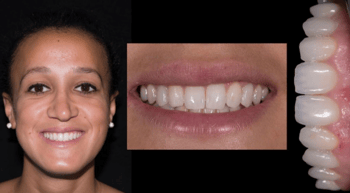A bright, white smile is important to many - discoloured teeth can seriously affect a person's confidence.
With a growing demand to have a brighter and whiter smile, more and more patients are requesting cosmetic treatments to improve the aesthetics of their teeth.
For best results, it is recommended that the patient's teeth are whitened before any restorative work is carried out; and expectations and clearly agreed between patient and practitioner.
This clinical case looks at how White Dental Beauty with 6% Hydrogen Peroxide can transform tooth colour, creating the perfect platform for composites.
 Gregory Camaleonte: Direct and Indirect Composites in the Anterior Region
Gregory Camaleonte: Direct and Indirect Composites in the Anterior Region
Dr Gregory Camaleonte graduated from the University of the Mediterranean with a degree in Dentistry in 2006. He then achieved his post-graduate in 2008, with a degree in Aesthetic and Adhesive dentistry.
He now owns a private practice in Marseille, France and is an accomplished author and co-author of several national publications. Dr Camaleonte is also a member of established groups like Style Italiano, Smile Acadamy, and Memisis.
The Importance of Setting Realistic Expectations
For any aesthetic treatment, the practitioner should encourage patients to express their motivations and desires. The dentist must devote time to listen, understand and offer support to the patient. After a thorough analysis of the existing problem, including clinical examination, x-rays and photos, a treatment plan should be proposed to the patient, who then may accept it or not. In case of refusal, it is important to understand the reasons and, if possible, to make another proposal in accordance with the patient’s expectations as long as they are realistic; the patient has to understand and accept the limits of the second proposal. When agreement is reached, study models are needed and through the production of a diagnostic wax-up, the dentist and laboratory can show the expected outcome to the patient.

Initial Steps
In the following case, we see how the treatment plan was managed after the patient refused the first proposal. A young female patient visited the practice to improve her smile. She asked for a fast treatment because she was getting married four months later. Her desire was to have white and aligned front teeth (Fig. 1).
X-rays of the deciduous teeth showed important root resorption. At this point, the patient was informed that, in order to obtain a long-lasting result, teeth 5.3 and 6.3 should be extracted, space would be created between the canines and central incisors using orthodontic treatment and then implants would be used to replace 1.2 and 2.2 after bleaching. The patient refused this proposal and reminded us of the need for a fast solution. At this point there is the option to either stop the treatment or to find an alternative solution. It was decided to propose to rebuild the teeth with indirect composite crowns on 5.3 and 6.3 and to make direct restorations to transform the canines in lateral incisors. It was explained to the patient that this treatment could accelerate the root resorption of the deciduous teeth and the patient accepts this risk (Fig 2.)
First thing to do is to make study models and send to the laboratory (DT Gilles Philip Laboratory). Digital design is used to guide the production of the wax-up. (Fig 3.)
The lab closed the spaces between canines and central incisors and transformed the deciduous teeth into permanent canines. Notice in this case that the gum level of the 1.3 and 2.3 is lower than the gum level of the teeth 2.1 and 1.1, this can be resolved in the final integration of the new smile. (Fig 4.)
![Figure 1 Figure 1]()
Figure 1
![Figure 2 Figure 2]()
Figure 2
![Figure 3 Figure 3]()
Figure 3
![Figure 4 Figure 4]()
Figure 4
Evaluating the Proposal

Before any intervention, the patient has to validate the proposal made in the laboratory (pictured, right - Fig 5). To precisely transfer the sculpture into the mouth of the patient we used silicone materials (Honigum Putty and Light).
With a #15 blade, the unwanted parts of the silicone stent were removed to obtain a very clean and precise mock up. At this point the patient can appreciate the final outcome and validates the treatment plan.
Whitening and White Dental Beauty
White Dental Beauty has a range of high quality tooth whitening gels includes 6% hydrogen peroxide and 5% 10% & 16% carbamide peroxide with NOVON, providing great versatility and clinical freedom to whiten patients’ teeth with as little as 30 minutes a day active treatment. Powered by NOVON, which uses an intelligent pH acceleration for maximum whitening effect, speeding up the whitening process whilst still being highly effective.
NOVON is a new, patented whitening compound that comprises hydrogen peroxide, urea and sodium tripolyphosphate and is the active ingredient in a new generation of tooth whitening gels. NOVON has a unique inherent feature in that, on application, it produces a ‘pH jump’ into the alkaline pH range. This ‘pH jump’ enhances the release of perhydroxyl ions which give a faster whitening effect. NOVON – containing gels can therefore produce a similar whitening effect within a shorter timeframe, in comparison to whitening using a regular gel. Alternatively, within the same time frame, a similar level of whitening can be achieved using a lower concentration of NOVON (Hyland et al., 2014). This should be an advantage to patients with sensitive teeth.
NOVON has 4 options for home bleaching:
- 6% Hydrogen Peroxide from as little as 30 minutes a day
- 16% Carbamide Peroxide from as little as 60 minutes a day
- 10% Carbamide Peroxide 2-4 hours overnight
- 5% Mild Carbamide Peroxide 2 hours a day
In this case, White Dental Beauty - 6% Hydrogen Peroxide was used for 14 days. Figure 6 shows the initial colour of the teeth and the strong saturation of the canines.
Figure 7 shows the colour of teeth after one-week of treatment and final color Figure 8. After bleaching, a silicone impression is made and the laboratory builds composite crowns on the deciduous teeth. The patient is reminded that because of the occlusion (even if we are able to avoid occlusal contacts in static occlusion), the root resorption of the 5.3 and 6.3 will certainly be accelerated.
The patient is still motivated and tells us she understands the risks.
![Figure 6 Figure 6]()
Figure 6
![Figure 7 Figure 7]()
Figure 7
![Figure 8 Figure 8]()
Figure 8


 Gregory Camaleonte: Direct and Indirect Composites in the Anterior Region
Gregory Camaleonte: Direct and Indirect Composites in the Anterior Region














